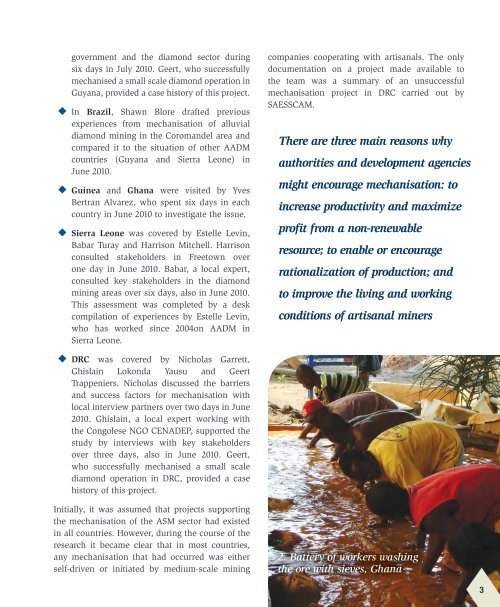Mechanisation-Alluvial-Artisanal-Diamond-Mining
Mechanisation-Alluvial-Artisanal-Diamond-Mining
Mechanisation-Alluvial-Artisanal-Diamond-Mining
- No tags were found...
You also want an ePaper? Increase the reach of your titles
YUMPU automatically turns print PDFs into web optimized ePapers that Google loves.
government and the diamond sector duringsix days in July 2010. Geert, who successfullymechanised a small scale diamond operation inGuyana, provided a case history of this project.◆◆In Brazil, Shawn Blore drafted previousexperiences from mechanisation of alluvialdiamond mining in the Coromandel area andcompared it to the situation of other AADMcountries (Guyana and Sierra Leone) inJune 2010.◆◆Guinea and Ghana were visited by YvesBertran Alvarez, who spent six days in eachcountry in June 2010 to investigate the issue.◆◆Sierra Leone was covered by Estelle Levin,Babar Turay and Harrison Mitchell. Harrisonconsulted stakeholders in Freetown overone day in June 2010. Babar, a local expert,consulted key stakeholders in the diamondmining areas over six days, also in June 2010.This assessment was completed by a deskcompilation of experiences by Estelle Levin,who has worked since 2004on AADM inSierra Leone.◆◆DRC was covered by Nicholas Garrett,Ghislain Lokonda Yausu and GeertTrappeniers. Nicholas discussed the barriersand success factors for mechanisation withlocal interview partners over two days in June2010. Ghislain, a local expert working withthe Congolese NGO CENADEP, supported thestudy by interviews with key stakeholdersover three days, also in June 2010. Geert,who successfully mechanised a small scalediamond operation in DRC, provided a casehistory of this project.Initially, it was assumed that projects supportingthe mechanisation of the ASM sector had existedin all countries. However, during the course of theresearch it became clear that in most countries,any mechanisation that had occurred was eitherself-driven or initiated by medium-scale miningcompanies cooperating with artisanals. The onlydocumentation on a project made available tothe team was a summary of an unsuccessfulmechanisation project in DRC carried out bySAESSCAM.There are three main reasons whyauthorities and development agenciesmight encourage mechanisation: toincrease productivity and maximizeprofit from a non‐renewableresource; to enable or encouragerationalization of production; andto improve the living and workingconditions of artisanal miners2. Battery of workers washingthe ore with sieves, Ghana3



